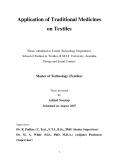
Back and neck pain
-
As science and technology has developed, the manner by which drugs can be delivered has grown. Medicines may be taken orally, applied as topical pastes, creams or oils, patches or administered by direct injection to the body. This research explores an alternative method for the delivery of therapeutic compounds to the body. The basis of the study involves the application of traditional medicinal compounds used to cure minor neck and back pains through transdermal topical application, using a textile substrate as the carrier.
 128p
128p  runthenight07
runthenight07
 01-03-2023
01-03-2023
 10
10
 3
3
 Download
Download
-
Tuyển tập báo cáo các nghiên cứu khoa học quốc tế ngành y học dành cho các bạn tham khảo đề tài: Process evaluation of a participatory ergonomics programme to prevent low back pain and neck pain among workers
 11p
11p  toshiba22
toshiba22
 22-11-2011
22-11-2011
 52
52
 5
5
 Download
Download
-
Toppling Falls Some patients maintain tone in antigravity muscles but fall over like a tree trunk, as if postural defenses had disengaged. There may be a consistent direction to such falls. The patient with cerebellar pathology may lean and topple over toward the side of the lesion. Patients with lesions of the vestibular system or its central pathways may experience lateral pulsion and toppling falls. Patients with progressive supranuclear palsy often fall over backwards. Falls of this nature occur in patients with advanced Parkinson's disease once postural instability has developed.
 5p
5p  ongxaemnumber1
ongxaemnumber1
 29-11-2010
29-11-2010
 88
88
 4
4
 Download
Download
-
Falls Falls are a common event, particularly among the elderly. Modest changes in balance function have been described in fit older subjects as a result of normal aging. Subtle deficits in sensory systems, attention, and motor reaction time contribute to the risk, and environmental hazards abound. Epidemiologic studies have identified a number of risk factors for falls, summarized in Table 24-3. A fall is not a neurologic problem, nor reason for referral to a specialist, but there are circumstances in which neurologic evaluation is appropriate.
 5p
5p  ongxaemnumber1
ongxaemnumber1
 29-11-2010
29-11-2010
 64
64
 4
4
 Download
Download
-
Neuromuscular Disease Patients with neuromuscular disease often have an abnormal gait, occasionally as a presenting feature. With distal weakness (peripheral neuropathy) the step height is increased to compensate for foot drop, and the sole of the foot may slap on the floor during weight acceptance. Neuropathy may be associated with a degree of sensory imbalance, as described above. Patients with myopathy or muscular dystrophy more typically exhibit proximal weakness. Weakness of the hip girdle may result in a degree of excess pelvic sway during locomotion.
 5p
5p  ongxaemnumber1
ongxaemnumber1
 29-11-2010
29-11-2010
 71
71
 2
2
 Download
Download
-
Parkinsonism and Freezing Gait Parkinson's disease (Chap. 366) is common, affecting 1% of the population 55. The stooped posture and shuffling gait are characteristic and distinctive features. Patients sometimes accelerate (festinate) with walking or display retropulsion. There may be difficulty with gait initiation (freezing) and a tendency to turn en bloc. Imbalance and falls may develop as the disease progresses over years.
 6p
6p  ongxaemnumber1
ongxaemnumber1
 29-11-2010
29-11-2010
 57
57
 3
3
 Download
Download
-
The posterior portion of the spine consists of the vertebral arches and seven processes. Each arch consists of paired cylindrical pedicles anteriorly and paired laminae posteriorly. The vertebral arch gives rise to two transverse processes laterally, one spinous process posteriorly, plus two superior and two inferior articular facets. The apposition of a superior and inferior facet constitutes a facet joint.
 6p
6p  ongxaemnumber1
ongxaemnumber1
 29-11-2010
29-11-2010
 68
68
 3
3
 Download
Download
-
Congenital Anomalies of the Lumbar Spine Spondylolysis is a bony defect in the pars interarticularis (a segment near the junction of the pedicle with the lamina) of the vertebra; the etiology may be a stress fracture in a congenitally abnormal segment. The defect (usually bilateral) is best visualized on oblique projections in plain x-rays, CT scan, or single photon emission CT (SPECT) bone scan and occurs in the setting of a single injury, repeated minor injuries, or growth.
 5p
5p  ongxaemnumber1
ongxaemnumber1
 29-11-2010
29-11-2010
 67
67
 4
4
 Download
Download
-
Shoulder Pain arising from the shoulder can on occasion mimic pain from the spine. If symptoms and signs of radiculopathy are absent, then the differential diagnosis includes mechanical shoulder pain (tendonitis, bursitis, rotator cuff tear, dislocation, adhesive capsulitis, and cuff impingement under the acromion) and referred pain (subdiaphragmatic irritation, angina, Pancoast tumor). Mechanical pain is often worse at night, associated with local shoulder tenderness and aggravated by abduction, internal rotation, or extension of the arm.
 13p
13p  ongxaemnumber1
ongxaemnumber1
 29-11-2010
29-11-2010
 89
89
 5
5
 Download
Download
-
Other Causes of Neck Pain Rheumatoid arthritis (RA) (Chap. 314) of the cervical apophyseal joints produces neck pain, stiffness, and limitation of motion. In advanced RA, synovitis of the atlantoaxial joint (C1-C2; Fig. 16-2) may damage the transverse ligament of the atlas, producing forward displacement of the atlas on the axis (atlantoaxial subluxation). Radiologic evidence of atlantoaxial subluxation occurs in 30% of patients with RA. Not surprisingly, the degree of subluxation correlates with the severity of erosive disease.
 5p
5p  ongxaemnumber1
ongxaemnumber1
 29-11-2010
29-11-2010
 235
235
 5
5
 Download
Download
-
Trauma to the Cervical Spine Trauma to the cervical spine (fractures, subluxation) places the spinal cord at risk for compression. Motor vehicle accidents, violent crimes, or falls account for 87% of spinal cord injuries (Chap. 372). Immediate immobilization of the neck is essential to minimize further spinal cord injury from movement of unstable cervical spine segments. A CT scan is the diagnostic procedure of choice for detection of acute fractures.
 5p
5p  ongxaemnumber1
ongxaemnumber1
 29-11-2010
29-11-2010
 71
71
 5
5
 Download
Download
-
Chronic Low Back Pain CLBP, defined as pain lasting 12 weeks, accounts for 50% of total back pain costs. Risk factors include obesity, female gender, older age, prior history of back pain, restricted spinal mobility, pain radiating into a leg, high levels of psychological distress, poor self-rated health, minimal physical activity, smoking, job dissatisfaction, and widespread pain. Combinations of these premorbid factors have been used to predict which individuals with ALBP are likely to develop CLBP. The initial approach to these patients is similar to that for ALBP.
 7p
7p  ongxaemnumber1
ongxaemnumber1
 29-11-2010
29-11-2010
 86
86
 3
3
 Download
Download
-
Algorithms for management of acute low back pain, age ≥18 years. A. Symptoms
 5p
5p  ongxaemnumber1
ongxaemnumber1
 29-11-2010
29-11-2010
 65
65
 4
4
 Download
Download
-
Psychiatric Disease CLBP may be encountered in patients who seek financial compensation; in malingerers; or in those with concurrent substance abuse, chronic anxiety states, or depression. Many patients with CLBP have a history of psychiatric illness (depression, anxiety, substance abuse) or childhood trauma (physical or sexual abuse) that antedates the onset of back pain. Preoperative psychological assessment has been used to exclude patients with marked psychological impairments that predict a poor surgical outcome. Unidentified The cause of low back pain occasionally remains unclear.
 5p
5p  ongxaemnumber1
ongxaemnumber1
 29-11-2010
29-11-2010
 64
64
 5
5
 Download
Download
-
MRI of lumbar herniated disk; left S1 radiculopathy. Sagittal T1weighted image on the left with arrows outlining disk margins. Sagittal T2 image on the right reveals a protruding disk at the L5-S1 level (arrows), which displaces the central thecal sac. The mechanism by which intervertebral disk injury causes back pain is controversial. The inner annulus fibrosus and nucleus pulposus are normally devoid of innervation. Inflammation and production of proinflammatory cytokines within the protruding or ruptured disk may trigger or perpetuate back pain.
 5p
5p  ongxaemnumber1
ongxaemnumber1
 29-11-2010
29-11-2010
 74
74
 4
4
 Download
Download
-
Referred Pain from Visceral Disease Diseases of the thorax, abdomen, or pelvis may refer pain to the posterior portion of the spinal segment that innervates the diseased organ. Occasionally, back pain may be the first and only manifestation. Upper abdominal diseases generally refer pain to the lower thoracic or upper lumbar region (eighth thoracic to the first and second lumbar vertebrae), lower abdominal diseases to the midlumbar region (second to fourth lumbar vertebrae), and pelvic diseases to the sacral region.
 4p
4p  ongxaemnumber1
ongxaemnumber1
 26-11-2010
26-11-2010
 73
73
 4
4
 Download
Download
-
Neoplasms (See also Chap. 374) Back pain is the most common neurologic symptom in patients with systemic cancer and may be the presenting symptom. The cause is usually vertebral metastases. Metastatic carcinoma (breast, lung, prostate, thyroid, kidney, gastrointestinal tract), multiple myeloma, and non-Hodgkin's and Hodgkin's lymphomas frequently involve the spine. Cancer-related back pain tends to be constant, dull, unrelieved by rest, and worse at night. By contrast, mechanical low back pain usually improves with rest.
 5p
5p  ongxaemnumber1
ongxaemnumber1
 26-11-2010
26-11-2010
 109
109
 5
5
 Download
Download
-
Degenerative Conditions Lumbar spinal stenosis describes a narrowed lumbar spinal canal. Neurogenic claudication is the usual symptom, consisting of back and buttock or leg pain induced by walking or standing and relieved by sitting. Symptoms in the legs are usually bilateral. Lumbar stenosis, by itself, is frequently asymptomatic, and the correlation between the severity of symptoms and degree of stenosis of the spinal canal is poor. Unlike vascular claudication, symptoms are often provoked by standing without walking.
 5p
5p  ongxaemnumber1
ongxaemnumber1
 26-11-2010
26-11-2010
 73
73
 3
3
 Download
Download
-
The Dichotomy of Inpatient and Outpatient Internal Medicine The hospital environment has transformed dramatically over the past few decades. In more recent times, emergency departments and critical care units have evolved to identify and manage critically ill patients, allowing them to survive formerly fatal diseases. There is increasing pressure to reduce the length of stay in the hospital and to manage complex disorders in the outpatient setting.
 5p
5p  ongxaemnumber1
ongxaemnumber1
 26-11-2010
26-11-2010
 90
90
 7
7
 Download
Download
CHỦ ĐỀ BẠN MUỐN TÌM































